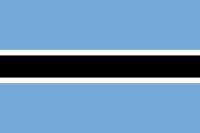Botswana

Botswana is a completely landlocked country in the centre of Southern Africa. One of Southern Africa’s longest rivers, the Okavango, flows into the north-western part of the country, forming the UNESCO World Heritage Site Okavango Delta. Botswana shares borders with South Africa, Namibia, Zambia and Zimbabwe.
The country covers an area of about 582,000 sq.km² and is relatively flat, at roughly 900 metres above sea level, with gentle undulations and occasional rocky outcrops. The Kalahari Desert occupies more than 70 % of the country, with valleys and pans etched across the landscape. The eastern part of Botswana contains the highest (1,500 metres) and the lowest (500 metres) points of elevation, with hills and deep valleys, whereas the flat vast western portion of the country is semi-arid with rocky outcrops.
The wet seasons occur with significant inter-annual variation, with frequent periods of severe drought. Rainfall is erratic, ranging from 250 mm per year in the south west to over 600mm in the north east. Winters are dry with temperatures dropping to an extreme of about minus 7 degrees Celsius, more commonly though they are nearer zero, with July being the coldest month. Summer months can be very hot, but mean temperatures seldom rise above 39 degrees Celsius.
Gaborone is the capital city and is located in the south east of Botswana. Other major towns include Francistown, Lobatse, Selebi-Phikwe and Jwaneng. There are sixteen Administrative Districts and associated Councils. The Central Government is represented in each District by the Department of District Administration, headed by a District Commissioner.
The total population size and density as per the 2011 Census are 2,024,904 and 3.5 persons per square kilometre respectively. The population is concentrated in the eastern parts of the country. These are better suited for arable production due to relatively favourable climatic and soil conditions.
Setswana is the national language, while English is the official language used in business and most Government affairs. There are also some indigenous languages which includes several ethnic groups dominated by those who are Setswana speaking, all of which are known as Batswana. Christianity is the main religion and there are a number if indigenous religions throughout the country.
The mining sector, and in particular diamond mining, is the major contributor to the export base, and government policy endeavours to reduce the vulnerability arising from the heavy dependence on diamonds.The livestock industry contributes about 80 % of agriculture’s share of Gross Domestic Product (GDP). Beef processing accounts for about 80 % of the livestock industry, and over 95 % of beef production is exported.Tourism continues to play an increasingly significant role in the diversification of the economy. Botswana’s impressive economic performance over the past four decades is mainly due to the success of its export sector.
Botswana is a multi-party democracy, with elections held every five years. The president is the Head of State.
The country’s wildlife resources are the foundation on which the tourism industry has been built. Botswana’s most famous wildlife habitat is the Okavango Delta, which covers some 16,800 km², and is a unique area of lagoons, reed-fringed waterways and islands. Other major attractions of Botswana’s pristine beauty can be found in the Kalahari Game Reserve, the Makgadikgadi Pans, the Chobe National Park, the Tuli block and the Tsodilo Hills Monument, a World Heritage Site with its collection of pre-historic art.
Botswana's International Airport: Sir Seretse Khama International Airport (airport code: GBE) is located at the capital, Gaborone. International flights include Air Botswana (to/from Harare, Johannesburg, Lusaka, Nairobi, Victoria Falls, and Windhoek), Air Zimbabwe and South African Airways. You can also take a long-distance bus from several South African towns/cities as well as to and from Zimbabwe.
Pages
- « first
- ‹ previous
- 1
- 2
- 3
- 4









